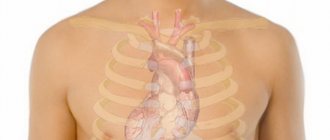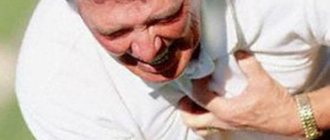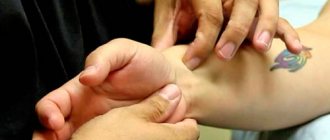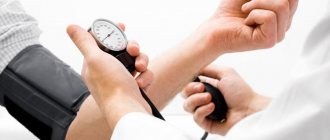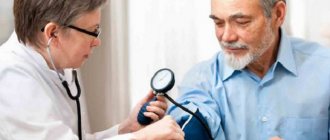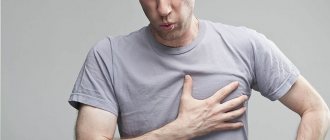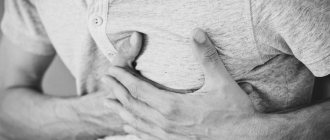September 15, 2011
A heart attack is often confused with angina. There is also a “silent heart attack”, which is not accompanied by pain at all. How to recognize and - most importantly - prevent a heart attack?
A heart attack is the death of part of the heart muscle due to insufficient blood flow to it. This disease has other names: heart attack or coronary thrombosis. Most often, a heart attack develops in those who eat poorly, move little and cannot cope with stress. A heart attack usually occurs when one of the blood vessels supplying the heart muscle becomes blocked by a blood clot. If the clot is large enough, it can completely deprive the heart of blood supply. Also, a heart attack can be caused by a spasm of the artery that supplies the myocardium - the heart muscle. Most often, this spasm occurs under the influence of stress.
What causes a heart attack?
— Age
is considered the main risk factor for heart attack.
It most often occurs in men over 45 years of age and women over 55 years of age. — A heart attack is one of the signs of the development of coronary heart disease. As a rule, it is preceded by attacks of angina pectoris. - Angina pectoris
- lack of nutrition of the heart muscle - increases the risk of a heart attack.
Heart attack and angina are often confused because their symptoms are very similar: chest pain and shortness of breath are observed in both cases. But the symptoms of angina pectoris are relieved by taking special medications within 15-30 minutes, but the symptoms of a heart attack are not. — Increased blood cholesterol or atherosclerosis. With these diseases, the risk of blood clots forming and blocking blood flow in the vessels of the heart is increased. In addition, risk factors
for heart attack include: - Diabetes - Hypertension - High-fat diet - Obesity - Smoking - Lack of physical activity - Stress - Genetic predisposition. Those whose relatives have suffered from heart attacks are at increased risk of developing this disease.
Anti-tuberculosis drugs
Another contraindication for drinking is treatment of tuberculosis. The instructions for the most common anti-tuberculosis drug, rifampicin, promise that “if you drink alcohol during treatment <...> the risk of hepatotoxicity increases.” In other words, you can be left without a liver.
This organ gets the most from ethanol - after digested food, water and medications are absorbed into the blood in the intestines, they first go to the liver. There, neutralizing enzymes take over - alcohol dehydrogenase and aldehyde dehydrogenase - which means that the liver has the highest concentration of poisonous acetic acetaldehyde and its breakdown products.
Rifampicin is also broken down in the liver, and toxic substances are also formed in the process. So the poison in the liver becomes more than usual, and some of its cells begin to die. In severe cases (if you combine the medicine with alcohol for weeks), it ends in hepatitis. The liver stops coping with any poisons and metabolic products, inflammation and jaundice begin, and in severe cases, disturbances of consciousness - from problems with sleep to lethargy and coma.
On the left is the liver of a healthy rat, on the right is inflammation and necrosis in the liver of a rat that was fed anti-tuberculosis drugs (isoniazid and rifampicin)
Debarupa Dutta Chakraborty et al. / International Journal of Applied Research in Natural Products, 2010
Share
True, the combination of alcohol with rifampicin does not always result in liver loss—some studies have not confirmed this relationship. But another anti-tuberculosis drug, isoniazid, turned out to be much more toxic: it not only affects the liver, but can also cause a disulfiram-like effect (we already talked about it above), that is, poison the body with acetaldehyde.
Heart Attack Symptoms
- Unpleasant sensations in the chest - Cough - Stitching pain in the chest - Dizziness - Shortness of breath - Pale with a grayish tint - Feelings of fear, panic - Nausea - Anxiety - Cold sweat on the face - Vomiting A person who is having a heart attack, first of all feels pain in the chest. Then the discomfort spreads to the neck, face and arms, and sometimes even to the back and stomach. The pain may last from a few minutes to several hours. Usually a person feels a little better if he changes his body position or lies down.
Pseudocardialgia or false pain in the heart with osteochondrosis
Cardialgia refers to all pain in the heart area until the exact disease causing it is determined. Pseudocardialgia is commonly called pain in the heart, which can have a variety of causes, and these are not heart diseases. Diseases that are accompanied by painful sensations in the heart area may include: neuralgia, neuropsychiatric disorders, vegetative-vascular dystonia, etc.
One of the diseases that most often causes false pain in the heart (pseudocardialgia) is osteochondrosis of the cervical or thoracic spine, as well as a herniated intervertebral disc. The symptoms of pseudocardialgia completely imitate pain in cardiovascular pathologies, but unlike them, they calm down when moving and intensify at rest (with real cardialgia, the opposite is true).
Osteochondrosis is a degenerative process in the intervertebral discs that affects the cervical and thoracic spine. As a result, the spinal nerves surrounding the chest are compressed and cause pain, which can be localized, including in the heart area. Hypertonicity of those muscles that are controlled by these nerves (pectoralis minor and major, intercostal muscles on the left side) also leads to increased pain. Cervical and thoracic osteochondrosis can also cause blockages of the costovertebral joints, causing pain to the patient.
The occurrence of false pain in the heart due to osteochondrosis or hernia is associated with certain movements or positions of the head and left arm (pulling to the side or moving behind the back provokes overstrain of the cervicothoracic nerve roots), at night they may appear for the first time or significantly intensify. The pain is provoked by physical activity, deep breathing, coughing or sneezing, hypothermia, and sudden movements.
There may also be an increase or decrease in reflexes in the hand, an increase or decrease in its sensitivity, tingling or goosebumps. Before heart pain occurs, a patient with osteochondrosis may experience pain in the back, along the spine, between the shoulder blades.
You can distinguish pseudocardialgia from cardiovascular pathology using an ECG (an electrocardiogram simply will not show the presence of heart disease). The diagnosis is usually confirmed by x-ray and computed tomography scan of the spinal column
After diagnosing false pain in a patient due to osteochondrosis or other pathologies of the spine, treatment by a vertebrologist is necessary. Treatment of pseudocardialgia primarily involves the treatment of osteochondrosis. Elimination of pain is ensured by taking analgesics, and manifestations of osteochondrosis are reduced by physiotherapeutic procedures.
One of the effective means is gentle manual therapy in the form of massage aimed at treating osteochondrosis, removing blockades from the spinal-costal joints, reducing the tone of the pectoral and intercostal muscles.
The massage is complemented by physiotherapy - laser treatment, phonophoresis, electrophoresis, etc. Author: K.M.N., Academician of the Russian Academy of Medical Sciences M.A. Bobyr
What is a “silent heart attack”?
In people over 75 years of age and with diabetes, a “silent heart attack” may occur, which is not accompanied by pain at all.
Experts estimate that approximately one fifth of such heart attacks are not diagnosed. Damage to the heart muscle in survivors of a “silent heart attack” progresses because it is not detected and treated. Abdominal fat destroys the heart
The maximum permissible waist circumference for women is 94 centimeters, for men – 102 centimeters. Exceeding these values increases the risk of cardiovascular disease. Find out more about the dangers of visceral (intra-abdominal) fat and how to get rid of it.
Antibiotics
A ban on alcohol can be found in the instructions for most antibiotics. For example, about metronidazole they write that the drug “...causes sensitization to alcohol” - that is, it prevents the body from protecting itself from it.
Here's what's really happening. Two enzymes are involved in ridding our cells of alcohol. The first, alcohol dehydrogenase, removes two hydrogen atoms from ethanol. The result is acetaldehyde (aka acetaldehyde) - and this is a much stronger poison than ethanol itself. It damages not only membranes, but also cellular proteins - when they react with it, they lose their shape and become useless.
To avoid being poisoned by acetaldehyde, cells use a second enzyme, aldehyde dehydrogenase. It removes another hydrogen, turning the toxin into completely safe acetic acid.
Stages of conversion of ethanol to acetic acid
Share
If a substance appears in the body that prevents aldehyde dehydrogenase from working, then alcohol becomes much more dangerous - because the cells convert it into acetaldehyde and stop there.
Aldehyde accumulates in the blood and can cause headaches, nausea, sweating, weakness and cramps. This is called the disulfiram-like effect
- after disulfiram, a drug used to treat alcoholism in the USSR. Disulfiram also blocks aldehyde dehydrogenase, so in its presence, drinking brings not only euphoria, but also the characteristic symptoms of aldehyde poisoning - and doctors, apparently, hoped that the severity of these symptoms would one day outweigh the joy of intoxication.
Some antibiotics (eg, metronidazole and cephalosporins) also appear to block aldehyde dehydrogenase. At least, if you take them with alcohol, the effect is approximately the same as from disulfiram. If, for example, you drink strong alcohol immediately after an intravenous injection of cephalosporin, the concentration of aldehyde can jump so much that Quincke's edema occurs - and this can be fatal.
But since antibiotics of different classes are not similar to each other either in chemical composition or in mechanisms of action, their relationships with ethanol can also develop differently. Some, for example, erythromycin and doxycycline, are simply less absorbed in the presence of alcohol - because it irritates the gastric mucosa and inhibits the movement of food into the intestines. This makes their concentrations in the blood lower, and they work, accordingly, worse.
Other antibiotics, on the contrary, themselves reduce the effect of drinking - for example, amoxicillin blocks the transporters of the excitatory mediator glutamate and thereby prevents a person from feeling euphoria (there have even been proposals to use amoxicillin to treat alcoholism). There are also those that work only better in the presence of alcohol - because they stay in the blood longer (this happens with levofloxacin). Finally, there are also antibiotics - like penicillin - that do not interact with alcohol at all (at least, we know nothing about it).
Vaccines
Finally, it is not recommended to combine alcohol with vaccines. The head of Rospotrebnadzor, Anna Popova, recommended that Russians stop drinking alcohol two weeks before vaccination and abstain from it for another three weeks after it. However, the instructions for using the Russian coronavirus vaccine do not contain any ban on alcohol (there is no ban on foreign vaccines either). This, however, does not mean that ethanol does not interact with the vaccine in any way - it’s just that the design of these clinical trials does not allow such conclusions to be drawn.
Other studies in this area provide conflicting answers. On the one hand, it is known that high doses of alcohol do not fully mature and kill not only red blood cells, but also immune cells - the same ones that are responsible for the reaction to the vaccine. On the other hand, in experiments on macaques, it turned out that “moderately drinking” animals (but not “alcoholic” macaques) developed a more stable response to the vaccine than “teetotalers.”
All we know about people is that those who drink little and often are less likely to catch seasonal colds and acute respiratory viral infections - and it seems that it is the frequency that is important. What this is connected with is still not clear - perhaps the fact is that ethanol suppresses the release of the stress hormone cortisol, which usually restrains the immune response. Or maybe alcohol simply dilates the blood vessels in the respiratory tract, which makes them warm up better and makes it harder for viruses to multiply.
Therefore, although many doctors still claim that alcohol, even in minimal doses, is harmful to health, from an immunological point of view it does not look like an absolute evil.
The dependence of the strength of the immune response on the amount of alcohol consumed looks U-shaped: 10-20 grams of alcohol per day corresponds to the maximum response to the vaccine. Probably, it was precisely this kind of consideration that prompted the director of the Gamaleya Center, Alexander Ginzburg, the leader of the group that created the Russian anti-coronavirus vaccine, to say that one glass of champagne after vaccination will not cause harm, and you need to completely give up alcohol only within 3 days after vaccination. Zoya Andreeva, Polina Loseva
Painkillers, antihistamines, tranquilizers
The instructions for many sedatives threaten drinkers with a variety of consequences, from “paradoxical reactions such as psychomotor agitation, aggressive behavior” to coma.
The point here is this. Because ethanol is a small molecule, it easily passes through the barrier that separates the brain from the general bloodstream. There it immediately begins to act on dopamine receptors - however, each time it becomes less and less effective. Alcohol gradually weakens the dopamine system, and the body loses sensitivity to its own level of the transmitter, that is, addiction occurs (for mice, for example, it is enough to drink just once). In addition, ethanol also affects other receptors on nerve cells - for example, it causes them to more actively absorb the inhibitory transmitter GABA. All together, this leads to the fact that alcohol ultimately turns out to be one of the strongest depressants.
This means that ethanol will only enhance the effects of any drugs that depress the central nervous system. For example, benzodiazepines, which doctors prescribe as tranquilizers to relieve seizures and anxiety. Or some antispasmodics, like pitofenone. Or first generation antihistamines - the same ones that often cause drowsiness (with new generations, they say, this problem no longer arises).
The stronger the “inhibitory” effect of the medicine itself, the more dangerous it is to combine it with alcohol. And if ethanol also accelerates the dissolution and absorption of the drug - this happens, for example, with one of the most powerful opioid analgesics, hydromorphone - then two glasses of vodka (220 ml of 40-proof alcohol) can cause an overdose and “slow down” the nervous system up to of death.
